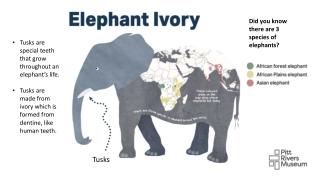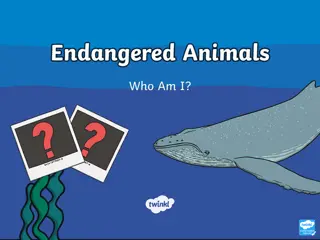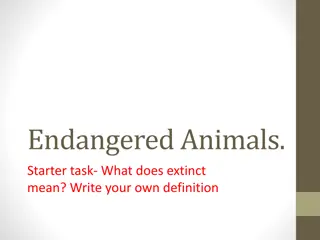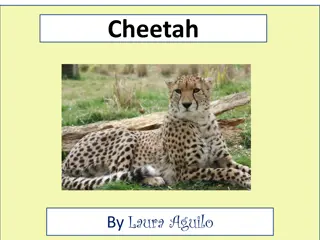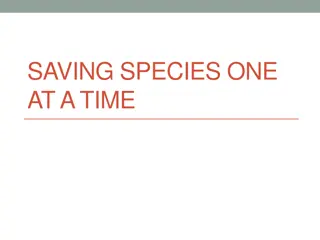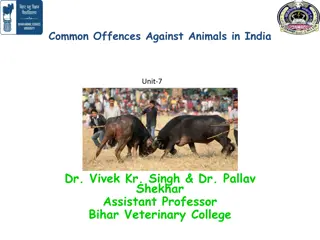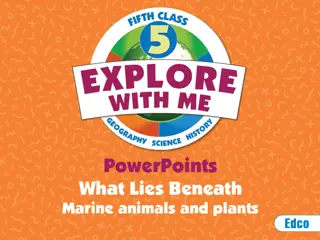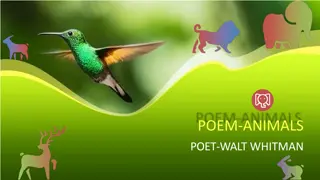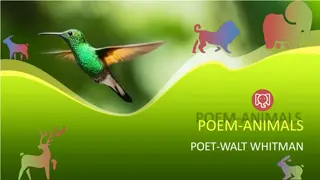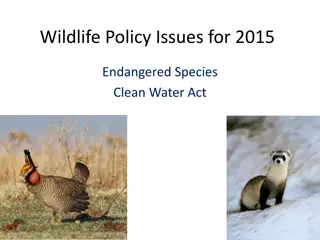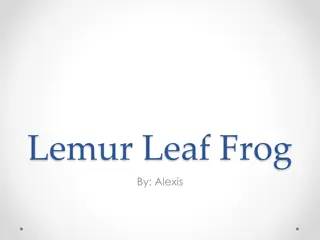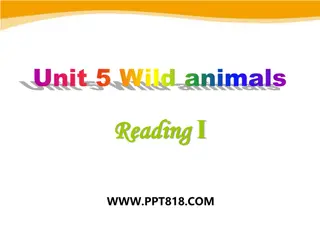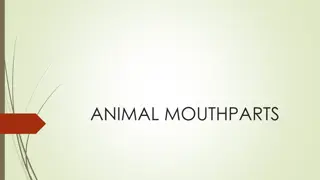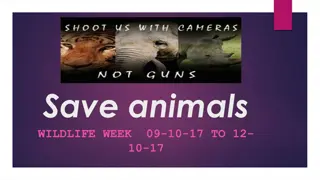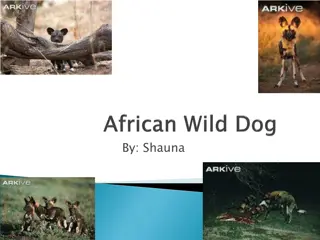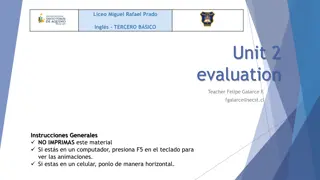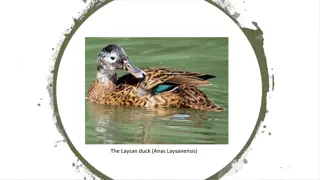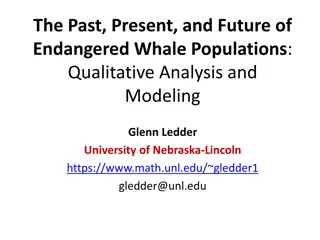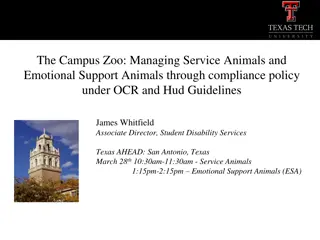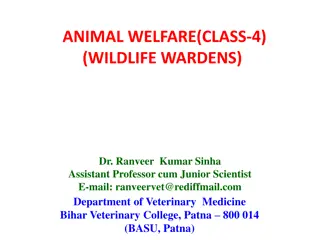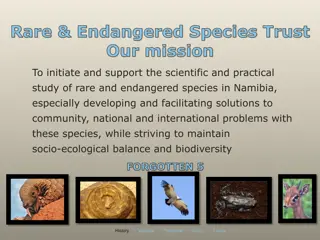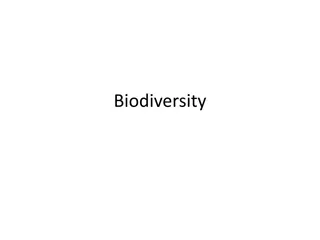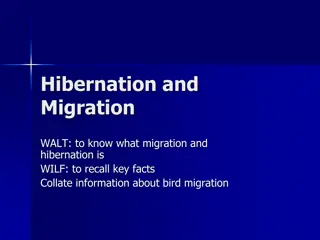The Impact of Elephant Ivory and Endangered Elephants
Elephants have tusks made of ivory, which has been historically used for various objects like games and luxury items. However, the demand for ivory has led to elephants being endangered due to illegal poaching. The material's popularity, durability, and smooth texture contributed to its widespread u
0 views • 10 slides
The Prevention of Cruelty to Animals Act, 1960 Overview
The Prevention of Cruelty to Animals Act, 1960, is a legislation in India aimed at safeguarding the well-being of animals and preventing unnecessary pain or suffering. It defines important terms like animals, domestic animals, local authority, owner, and outlines the responsibilities of individuals
0 views • 16 slides
Common Offences Against Animals in India: Overview and Consequences
There are three common offences against animals in India: mischief, cruelty, and bestiality. Mischief involves killing, poisoning, or harming animals, punishable under IPC Sections 428 and 429. Cruelty includes acts like beating, overloading, and starvation, regulated by the Prevention of Cruelty to
1 views • 21 slides
Endangered Animal Quiz and Task Time
Engage in a quiz to identify endangered animals, learn about their characteristics, and discover factors threatening their existence. After the quiz, take part in an activity to create a fact file detailing the chosen animal's habitat, population status, threats, and preventive measures to avoid ext
0 views • 10 slides
Endangered Animals and Extinction
Explore the concept of endangered animals and extinction through tasks that involve listing endangered animals, understanding reasons for extinction, researching specific endangered species, and contemplating the ethical dilemma of keeping animals in zoos. Engage in critical thinking and research to
1 views • 8 slides
Importance of Transport System in Animals for Oxygen Supply
Animals require a transport system to meet tissue oxygen demands efficiently. The size limit for oxygen diffusion alone is around 1 mm due to the proportional increase in radius and diffusion properties. Blood is crucial for transporting oxygen, nutrients, waste products, cells, and heat, as well as
0 views • 17 slides
Discover the Fascinating World of Cheetahs
Learn about cheetahs, the fastest land animals, including their diet, habitat, life cycle, interactions with other animals, and interesting facts such as tear marks and their endangered status. Explore images showcasing these magnificent creatures in their natural environment.
0 views • 6 slides
Conservation Strategies to Protect Endangered Species
Methods like captive-breeding programs, preserving genetic material, utilizing zoos and parks, preserving habitats, and implementing conservation strategies are crucial in the efforts to save endangered species from extinction.
0 views • 18 slides
Animals by Walt Whitman: Embracing the Virtues of Animals Over Humans
Walt Whitman's poem "Animals" expresses a longing to live among animals due to their peaceful and self-controlled nature, contrasting them with the perceived greed and jealousy of humans. The poet finds solace in the virtues displayed by animals and reflects on their simplicity and contentment, high
0 views • 16 slides
Learn Plural and Singular Forms with Animals in English
This lesson focuses on differentiating between plural and singular forms using animals as examples. Students will learn to write sentences using "They're" for plural and "It's a" for singular, while looking at pictures of various animals. By the end of the lesson, students will be confident in using
1 views • 6 slides
Overview of Laboratory Animals and Their Uses in Biomedical Research
Laboratory animals play a crucial role in biomedical research, serving as models for studying various conditions affecting humans and animals. They must thrive in controlled conditions and are used to test hypotheses and drugs. Commonly used lab animals include rodents, lagomorphs, canines, felines,
0 views • 9 slides
Aquatic Adaptation in Animals
Aquatic adaptation refers to the changes in an animal's body organization to thrive in a water habitat. Vertebrates have evolved to lead partial or total aquatic lives, showcasing various adaptations. Water as a habitat offers a homogenous medium, stable conditions, and rich food resources. Aquatic
1 views • 9 slides
Common Offences Against Animals in India: Understanding Mischief, Cruelty, and Bestiality
Offences against animals in India encompass mischief, cruelty, and bestiality. Mischief involves killing, poisoning, and maiming animals, punishable under the IPC. Maiming makes animals permanently useless, often to harm owners. Cruelty includes beating, overloading, starvation, and other forms of a
1 views • 17 slides
Fascinating Marine Animals: Exploring the Diversity of Ocean Life
Dive into the mesmerizing world of marine animals and plants, where millions of species thrive in the vast ocean. Discover the enchanting features of fish, including their ability to adapt, change appearance, and employ camouflage. Explore the unique characteristics of seahorses, known for their col
1 views • 35 slides
Walt Whitman's Poem: Animals and Their Serenity
Walt Whitman's poem explores the tranquility and simplicity of animals compared to the complexities of human existence. He marvels at how animals do not dwell on dissatisfaction or material possession, finding solace in their self-sufficiency. Through vivid imagery and free verse, the poet reflects
0 views • 7 slides
Insights into Hibernation in Animals: Functions and Varieties
Hibernation is a fascinating biological phenomenon observed in various animals, enabling them to survive harsh conditions by conserving energy. This state of inactivity and metabolic depression is crucial for species like bears, pygmy possums, and bats during winter months. Animals hibernate to cope
0 views • 15 slides
Service and Assistance Animals Guidelines at RIT
Service and Assistance Animals Guidelines at RIT provide information on the definition of service and assistance animals, request procedures, expectations of animal and owner, and how to address concerns. The policy distinguishes between service animals trained to perform tasks for individuals with
1 views • 15 slides
Insights into Walt Whitman's Poem "Animals": A Journey of Self-Discovery
Walt Whitman's poem "Animals" delves into the poet's contemplation of living with animals for their peaceful and self-contained nature compared to complex human interactions. Through vivid imagery and free verse, Whitman expresses admiration for animals' contentment, lack of materialistic desires, a
4 views • 7 slides
Learn About Animals Through This Interactive PowerPoint Presentation
Explore the fascinating world of animals in this interactive PowerPoint presentation. Discover the six groups of animals categorized in unique classes with fun facts and engaging visuals. You'll get to learn about mammals, birds, and more while filling in blanks and pasting pictures of different ani
0 views • 29 slides
Service Animals for Veterans in Georgia: A Guide to VA Guidance
Veterans in Georgia can benefit from service animals, including guide dogs and trained service animals, to assist with physical or mental impairments. The VA provides guidelines for evaluating, approving, and supporting veterans in receiving and caring for service animals. This includes information
0 views • 8 slides
Become a Foster Parent for AAWL: Steps and Requirements
Join the Arizona Animal Welfare League's Foster Care Program by following the steps outlined: complete the application, attend orientation, and provide a separate living space and transportation for foster animals. Learn why fostering young animals is crucial and the guidelines for integrating them
0 views • 14 slides
Animal Welfare and Five Freedoms in Farming
Animal welfare encompasses physical and mental wellbeing, allowing animals to express natural behaviors. The Five Freedoms outline essential welfare needs, making sure animals are free from hunger, discomfort, pain, fear, and distress. The Farm Animal Welfare Council ensures these needs are met for
2 views • 16 slides
Wildlife Policy Issues for 2015: Endangered Species & Clean Water Act
Overview of policy issues surrounding endangered species and clean water act in 2015, including definitions, history, causes of endangerment, petition and listing factors. Focus on protecting species like the Lesser Prairie Chicken and Black-footed Ferret. Mention of Kansas' threatened and endangere
0 views • 21 slides
The Endangered Lemur Leaf Frog: A Rare Species Facing Extinction
The Lemur Leaf Frog, with its green color, brown spots, and unique features, is a critically endangered species found in only three countries. Weighing just 2 grams and the size of a golf ball, they are at risk due to Chytridiomycosis. Efforts are being made to protect and breed them in zoos to prev
0 views • 10 slides
Discovering Wild Animals: A Journey Through Fascinating Creatures
Delve into the world of wild animals through a captivating reading session featuring giraffes, bears, kangaroos, dolphins, elephants, squirrels, and giant pandas. Learn about their unique characteristics, behaviors, and the importance of conservation efforts to protect these magnificent creatures. E
1 views • 22 slides
Evolutionary Adaptations in Animals and Their Mouthparts
Environmental conditions have influenced the evolution of animals, leading to adaptations that allow them to survive and thrive. One crucial aspect is the relationship between animals, their environment, and food sources, shaping physical traits like mouthparts for efficient feeding. Explore how dif
0 views • 9 slides
Save Animals - Wildlife Week Awareness Campaign
Explore the importance of animals in nature and the cruel acts of killing them for various purposes. Learn how we can protect and respect animals to prevent extinction. Take a stand against harming animals for selfish needs.
0 views • 18 slides
Environmental Considerations in U.S. Oil and Gas Industry
This presentation delves into the various environmental considerations within the U.S. oil and gas industry, covering nationwide and regional issues, industry examples, wildlife impacts, best practices, and cultural resources. It emphasizes federal regulations such as the Endangered Species Act and
0 views • 17 slides
Fascinating Facts About African Wild Dogs
African wild dogs, also known as painted wolves, are versatile animals found in mountain forests and deserts in Africa. They have a unique appearance with colors of black, gray, yellow, and white, and exhibit interesting behaviors like competing with hyenas and lions for food. These social animals l
0 views • 10 slides
Animal Evaluation for Third Grade English Students at Liceo Miguel Rafael Prado
Evaluate your knowledge of animals with this interactive assessment designed for third-grade English students at Liceo Miguel Rafael Prado. Answer questions about different animals and their characteristics, including favorite animals and distinguishing features. Practice your English vocabulary whi
0 views • 15 slides
The Critically Endangered Laysan Duck: A Story of Survival
The Laysan duck, also known as the Laysan teal, is a critically endangered species originally found on various Hawaiian islands but now restricted to Laysan Island and two other atolls. Driven to the brink of extinction with only 12 individuals left in 1912, conservation efforts are being made to br
0 views • 4 slides
Endangered Whale Populations through Mathematical Modeling
Explore the past, present, and future of endangered whale populations through qualitative analysis and mathematical modeling. Delve into resource management models, input data analysis, species control parameters, and the importance of managing natural resources for the conservation of whales. Learn
0 views • 29 slides
Learn Where Different Animals Live - Educational English Lesson for Class Two Students
In this engaging English lesson designed for Class Two students, they will explore where animals live through visual aids and interactive learning activities. The lesson covers various animals like birds, snakes, cows, tigers, and more, teaching students about their habitats in a fun and educational
0 views • 22 slides
Managing Service Animals and Emotional Support Animals in Compliance with ADA and HUD Guidelines
This presentation by James Whitfield explores the management of service animals and emotional support animals on campus under OCR and HUD guidelines. The session covers defining service animals, identifying them in training, recognizing emotional support animals, and understanding the distinctions b
1 views • 52 slides
Wildlife Warden Duties and Performing Animals Welfare Guidelines
Every state and union territory in India has a Wildlife Advisory Board to aid in wildlife protection, with Wildlife Wardens playing a key role in conservation efforts. They focus on preventing poaching, protecting wildlife habitats, and engaging with local communities. Additionally, guidelines are s
0 views • 8 slides
Rare & Endangered Species Trust: Protecting Namibia's Vultures and Pangolins
Rare & Endangered Species Trust in Namibia focuses on studying and supporting rare and endangered species, particularly vultures and pangolins. With a mission to find solutions to conservation challenges and maintain biodiversity, the trust highlights the history, crisis, and future prospects for th
0 views • 19 slides
The Importance of Biodiversity Conservation in Megadiverse Countries
Biodiversity is crucial for maintaining a healthy ecosystem, but over 130,000 animal species are endangered due to threats like habitat loss, poaching, and man-wildlife conflicts. Megadiverse countries like Australia, India, and Brazil play a significant role in biodiversity conservation efforts to
1 views • 13 slides
Migration and Hibernation in Animals
Explore the fascinating behaviors of birds during migration and animals during hibernation. Discover how animals adapt to survive in changing environments, the reasons behind hibernation, dangers involved, and how different animals prepare for winter. Learn about light sleepers that are not true hib
0 views • 17 slides
Animal Survival – A Threat to Biodiversity
Biodiversity faces a critical threat as animal survival is endangered by factors like deforestation, poaching, and climate change. From the declining rainforest area to the endangered status of tigers, great apes, elephants, pandas, and polar bears, various species are at risk of extinction. The ala
0 views • 53 slides
Efforts to Save Biodiversity: Strategies and Controversies
Efforts to save individual species include captive breeding, genetic preservation, and legal protections, while protecting entire ecosystems can safeguard multiple species. The Endangered Species Act imposes regulations to preserve endangered plants and animals. However, conservation efforts may spa
0 views • 6 slides
